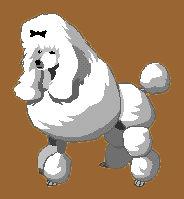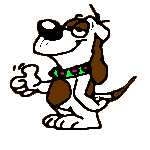











|





 





|
|

Stone-aged people tamed dogs to help them track game. About eight thousand years ago, ancient Egyptians raised Saluki hunting dogs. Saluki is an arabic word meaning noble one. These dogs are probably the oldest known breed.
Quite a few breeds claim to be the oldest, the first real dog. We do know that as far as groups go, the hounds and certain Northern type breeds are among the oldest documented. The greyhound type of dogs (the Pharaoh, Saluki, Ibizan, Basenji and Afghan) were well established in ancient Egypt 5000 years ago. It has been suggested that the Dalmatian was depicted in paintings dating back as far as 2000 years ago, and the Assyrians developed large mastiff-like breeds for use in hunting and war.
Spiritually speaking, the dog to the Ancient civilizations was most frequently associated with death and the afterlife. Afterall, he was a known scavenger. The Old Testament scorns the dog for returning to it's vomit. In Greek mythology Cerberus, a three headed dog, guarded Hades. The Maya of the (as yet undiscovered) New World also associated their dog with death in the form of Nahua Xolotl, or Pek, the dog of lightning who heralded the coming of death. Perhaps it was the hunting habits of the dog, the sight of the pack tearing it's prey to shreds as opposed to the "clean" kill of the great cats or birds of prey.
Although the dog was used as an aid to the shepherd, it was generally considered an unclean animal. Both the Hebrew and Moslem cultures forbid eating an animal that had been "torn by dogs", and no doubt, the threat of rabies made this a wise practice. (The Moslems made exception for the Saluki , as it was considered a Gift of Allah.)
As is always the case, when a country or civilization is well off, so are the dogs. During the reign of the early Greek, and later, the Roman Empire, the status of dogs began to change again. The dog was kept not only as a hunter, herder, & guardian, but also as a beloved pet. Dogs began to appear in sculpture, and had their portraits painted. Some of the world's finest canine art dates to this time period.
That their fidelity was noted and rewarded is evidenced both by the story of Odysses' hound Argus, and by the real dog "Delta". Unearthed at Pompeii were the remains of a dog stretched out beside a child. The dog, "Delta", wore a silver collar which told that he belonged to Severinus, whose life he had saved from a wolf.
However, not all dogs were so highly valued. Ever on the lookout for something new to present at the Colossium, the Romans collected animals (including dogs) from all corners of the known world. In A.D. 391,Quintus Aurelis Symmachus, the Roman consul, wrote thanking his brother for the seven hounds (Irish Wolfhounds) saying that "All Rome viewed them with wonder". The Romans were also very much impressed with the quality of British hounds and mastiffs, as fighting dogs against a wide variety of lions, leopards, gladiators, slaves, and even elephants.
In the Far East, what kind of a life a dog lead depended wholly on it's breed. The dog could find itself employed as a hunter (the noble Chow Chow), fighter (the Chinese Shar Pei), or as the main course at dinner. Dogs very much like today's Pekingese and Japanese Chins were of an established type featuring pushed in faces and curled tails. In the Royal Courts, they were considered so important that they were assigned their own human servants. Then, as now, they were highly prized, pampered house pets, at one time carried along the trade routes as gifts of high esteem for emperors and kings.
In nearby Tibet, the Tibetan Terrier was one such breed. It was given as a token of favor with the local people, not to be bought or sold for any price. Not a real terrier, the breed did not hunt, herd, or gaurd. It's true value lie in the fact that it was believed to be a 'Luck Bringer'.
In Europe, the Middle Ages saw the purebred dog become the prized possession of Kings, Noblemen, and surprisingly, Church Officials as a new use was developed for the dog when hunting for sport became popular. The Bloodhound, who takes his name from 'Blooded Hound', or purebred, traces back to the St. Hubert hounds of the seventh century A.D., when everybody who was anybody kept their own pack of hounds.
The English Mastiff and Greyhound became standardized, recognizable breeds this time, as did a few of the herding breeds. The lap dog finally became popular in Europe as the ladies of the court took to them as 'comforters'. Even the dog's collar became a measure of the dog's importance, some examples being made of gold, silver, white leather, and velvet. The Great Dane & the Mastiff accompanied their masters into battle fitted with spiked collars, and occasionally, their own suit of armor. A number of breeds were developed for 'sport' of another kind - bull and bear baiting, as well as rat catching, and pit fighting.
Dogs were everywhere. Early Church documents show that it was common for the parishoners to bring their dogs to services with them as footwarmers. Dogs figured prominately enough in daily life that they became the objects of a number of laws. For instance, the Ownership of a Scottish Deerhound or Greyhound was kept off limits from all but the Nobility. And there were laws on the books that decreed that certain sizes of dogs kept near the King's forests had to be crippled to prevent their being used for poaching. Only dogs small enough to jump through a hoop of a set size were allowed to go unharmed.
But the common man had dogs, not always readily recognizable to us today, the names referred more to a dog's use than it's particular breed. For example; Ban Dogs - fierce dogs kept tied during the day and loosed at night to guard, and Turnspits - small dogs used to run on the wheels that turned the spits over the great open fireplaces. Of couse, every locality had it's own variety of Terrier ideally suited to hunting the local varmints. There was an abundance of various and sundry hounds to hunt small game, and the ever present shepherd's dog.
    
 Please read our Legal Statement and Privacy Policy.
|